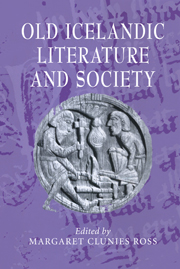Book contents
- Frontmatter
- Contents
- List of contributors
- Introduction
- 1 Social institutions and belief systems of medieval Iceland (c. 870–1400) and their relations to literary production
- 2 From orality to literacy in medieval Iceland
- 3 Poetry and its changing importance in medieval Icelandic culture
- 4 Óláfr Þórðarson hvítaskád and oral poetry in the west of Iceland c 1250: the evidence of references to poetry in The Third Grammatical Treatise
- 5 The conservation and reinterpretation of myth in medieval Icelandic writings
- 6 Medieval Icelandic artes poeticae
- 7 A useful past: historical writing in medieval Iceland
- 8 Sagas of Icelanders (Ílendinga sögur) and þœttir as the literary representation of a new social space
- 9 The contemporary sagas and their social context
- 10 The Matter of the North: fiction and uncertain identities in thirteenth-century Iceland
- 11 Romance in Iceland
- 12 The Bible and biblical interpretation in medieval Iceland
- 13 Sagas of saints
- Index
- CAMBRIDGE STUDIES IN MEDIEVAL LITERATURE
13 - Sagas of saints
Published online by Cambridge University Press: 15 October 2009
- Frontmatter
- Contents
- List of contributors
- Introduction
- 1 Social institutions and belief systems of medieval Iceland (c. 870–1400) and their relations to literary production
- 2 From orality to literacy in medieval Iceland
- 3 Poetry and its changing importance in medieval Icelandic culture
- 4 Óláfr Þórðarson hvítaskád and oral poetry in the west of Iceland c 1250: the evidence of references to poetry in The Third Grammatical Treatise
- 5 The conservation and reinterpretation of myth in medieval Icelandic writings
- 6 Medieval Icelandic artes poeticae
- 7 A useful past: historical writing in medieval Iceland
- 8 Sagas of Icelanders (Ílendinga sögur) and þœttir as the literary representation of a new social space
- 9 The contemporary sagas and their social context
- 10 The Matter of the North: fiction and uncertain identities in thirteenth-century Iceland
- 11 Romance in Iceland
- 12 The Bible and biblical interpretation in medieval Iceland
- 13 Sagas of saints
- Index
- CAMBRIDGE STUDIES IN MEDIEVAL LITERATURE
Summary
In the name of our Saviour Lord Jesus Christ, here begins a little booklet of St Michael the Archangel, written and composed for the sole purpose that it always be read on Michael's feast-day for the enjoyment of the parishioners, especially in those places where he is patron, so that his remembrance will become all the sweeter in the thoughts of righteous men, the better known his great excellence becomes to everyone by means of this little work. (Prologue to Michaels saga by Bergr Sokkason)
The social context of the literature about saints – hagiography, heilagra manna sögur – is primarily a religious one. The saints were the heroes of the Church, whose lives were illustrations of Christian perfection, and whose powers of intercession could be invoked in any conceivable emergency. Stories of the lives and miracles of holy men and women provided instruction and hope for both educated and illiterate believers. Vernacular narratives about saints, like those with secular subject matter, are known as sagas. Saints' sagas constitute the main body of Icelandic hagiography. There is in addition a limited amount of vernacular poetry, but only scattered fragments of Latin texts have survived.
The earliest sagas of saints were translations of Latin vitae made in the twelfth century. The years around 1200 saw the composition and translation of vitae and miracles of two native saints, Bishop Þorlákr Þórhallsson of Skálholt and Bishop Jón Qgmundarson of Hólar, whose cults developed at that time.
Information
- Type
- Chapter
- Information
- Old Icelandic Literature and Society , pp. 302 - 325Publisher: Cambridge University PressPrint publication year: 2000
Accessibility standard: Unknown
- 2
- Cited by
